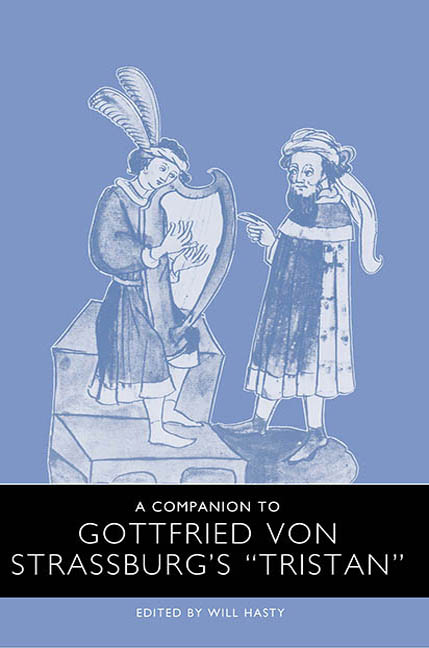Book contents
- Frontmatter
- Contents
- Acknowledgments
- Introduction: The Challenge of Gottfried's Tristan
- I Cultural and Social Contexts
- II Figures, Themes, Episodes
- Gottfried's Adaptation of the Story of Riwalin and Blanscheflur
- This Drink Will Be the Death of You: Interpreting the Love Potion in Gottfried's Tristan
- God, Religion, and Ambiguity in Tristan
- The Female Figures in Gottfried's Tristan and Isolde
- Performances of Love: Tristan and Isolde at Court
- Duplicity and Duplexity: The Isolde of the White Hands Sequence
- III Gottfried's Narrative Art
- IV The Medieval and Modern Reception of Gottfried's Tristan
- Notes on the Contributors
- Index
Duplicity and Duplexity: The Isolde of the White Hands Sequence
from II - Figures, Themes, Episodes
Published online by Cambridge University Press: 28 April 2017
- Frontmatter
- Contents
- Acknowledgments
- Introduction: The Challenge of Gottfried's Tristan
- I Cultural and Social Contexts
- II Figures, Themes, Episodes
- Gottfried's Adaptation of the Story of Riwalin and Blanscheflur
- This Drink Will Be the Death of You: Interpreting the Love Potion in Gottfried's Tristan
- God, Religion, and Ambiguity in Tristan
- The Female Figures in Gottfried's Tristan and Isolde
- Performances of Love: Tristan and Isolde at Court
- Duplicity and Duplexity: The Isolde of the White Hands Sequence
- III Gottfried's Narrative Art
- IV The Medieval and Modern Reception of Gottfried's Tristan
- Notes on the Contributors
- Index
Summary
The legend of a passion strong enough to defy the most vigilantly patrolled social conventions provided a rich quarry for medieval artists working in various media. Scenes from the Tristan and Isolde story left their mark on medieval buildings such as the floor tiles of Chertsey Abbey, on medieval embroideries and tapestries and in the form of sculptures on ivory and wooden caskets. The spatial demands of the pictorial and plastic media typically dictated a selective procedure in which key scenes were chosen (the Orchard Scene was a favorite) capable of compressing the legend into a form epitomizing its essence as individual artists perceived it (see Curschmann). Even in the field of literature a long and rather complex story was sometimes distilled into one episode, as in Marie de France's Lai de Chevrefueil, which advances a summa of the lovers’ plight in the image of a hazel branch entwined with honeysuckle, the symbiosis illustrating how together the lovers may prosper but parted they must die (see the introduction of Grimbert ed., esp. xxix–xxxiii). The impulse towards compression is clearly observable in the best-known modern realization of the theme, Richard Wagner's opera, Tristan und Isolde (1859) where we find the conception distinctive to that composer of the Liebestod (informed by conceptions derived from Novalis and Schopenhauer) taking center-stage. In the music drama the lovers’ intense spiritual union achieves its highest consummation when they are transposed from the material sphere to the realms of Night and Death, where they win redemption from the imperfections of their mortal condition.
Wagner's abbreviated and highly subjective treatment of his medieval material was quite unlike that of his medieval predecessor, Gottfried von Strassburg (see the studies of Curtis and Groos), who set himself the task of conveying to German soil a faithful version of the legend based on the French romance of Thômas von Britanje (an author about whom little is known beyond the fact that he was a clerc who had passed through the schools and that he had some knowledge of England — see Bromiley 14–21).
- Type
- Chapter
- Information
- A Companion to Gottfried von Strassburg's Tristan , pp. 183 - 202Publisher: Boydell & BrewerPrint publication year: 2003



